
German postcard by Ross Verlag, Berlin, no. 40/1. Photo: IFA / United Artists. Douglas Fairbanks in The Thief of Bagdad (Raoul Walsh, 1924).
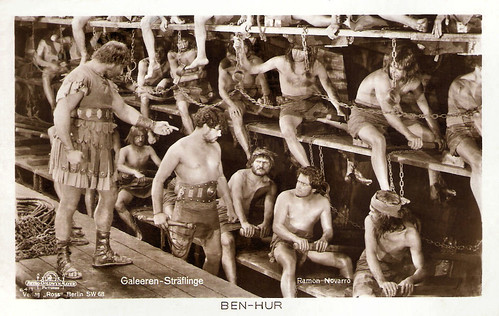
German postcard by Ross Verlag, Berlin, no. 64/1. Photo: Metro-Goldwyn-Mayer (MGM) / Fanamet. Publicity still for Ben-Hur: A Tale of the Christ (Fred Niblo, 1925) with Ramon Novarro. Caption: 'Galeeren-Sträflinge' (convicts).
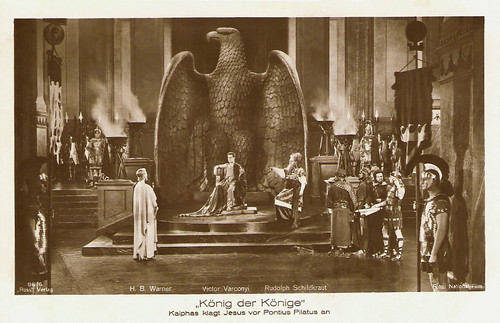
German postcard by Ross Verlag, no. 86/6. Photo: National-Film. Publicity still for King of Kings (Cecil B. De Mille, 1927) with Victor Varconi, H.B. Warner and Rudolph Schildkraut. Caption: Caiphas accuses Jesus before Pontius Pilate.
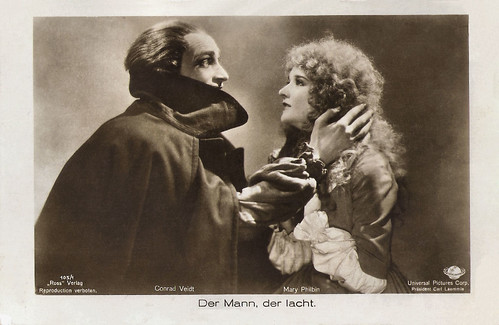
German postcard by Ross Verlag, no. 105/1. Photo: Universal Pictures Corp. Publicity still for The Man Who Laughs (Paul Leni, 1928) with Conrad Veidt and Mary Philbin.
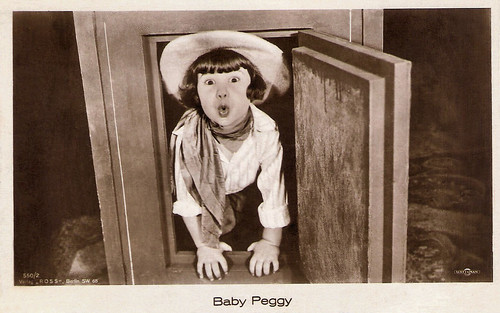
Baby Peggy. German postcard by Ross Verlag, Berlin, no. 550/2, 1919-1924. Photo: Unifilman.
Crisis in the German film industry
The Golden Twenties was a particularly vibrant period in the history of Berlin. After the Greater Berlin Act (1920), the city became the third-largest municipality in the world and experienced its heyday as a major world city. Berlin attracted a large number of foreign visitors working in the very well-developed film industry. Weimar cinema enjoyed primacy at home and growing recognition abroad
In 1917 a few large German film companies came together to unite production, distribution and presentation under one studio, the Ufa (Universum Film AG) in Berlin-Tempelhof. In 1921, the studio was privatised. Ufa was now the largest and most advanced studio in Europe. It brought together the greatest talents, including the producer Erich Pommer, and the directors Fritz Lang, Friedrich Wilhelm Murnau and Ernst Lubitsch.
The major Hollywood studios, which had offices in Berlin, sought to attract the most talented directors. In 1922, Paramount brought Ernst Lubitsch to Hollywood. He became the uncontested master of the elegant American comedy, and the famous 'Lubitsch touch'. Friedrich Wilhelm Murnau followed a few years later.
The Weimar Republic lived in the shadow of inflation until late 1923. After the stabilisation of the German currency starting in November 1924, the German film industry, in general, entered a period of crisis: foreign sales stalled due to low-profit margins, and the German market became profitable once again for American film studios. The new currency allowed importers to buy foreign films at a more reasonable cost and imports took over a larger share of the market. In 1923, 417 features were censored in Germany: including 253 German productions and 103 American. Five years later, 520 features were censored of which 221 were German and 205 American films.
Ufa's managers made severe miscalculations concerning two large-scale productions, Die Nibelungen (1924) and Metropolis (1926). This situation was made even worse as the result of the Parufamet agreement, Ufa had entered into in 1925 with the American companies Paramount Pictures and Metro-Goldwyn-Mayer. In March 1927, the company faced bankruptcy. Thomas J. Saunders in his study 'Hollywood in Berlin: American Cinema and Weimar Germany': "American tariffs and resistance to German imports, as well as the departure of leading filmmakers to the United States, threatened to reduce German cinema to an appendage of Hollywood."
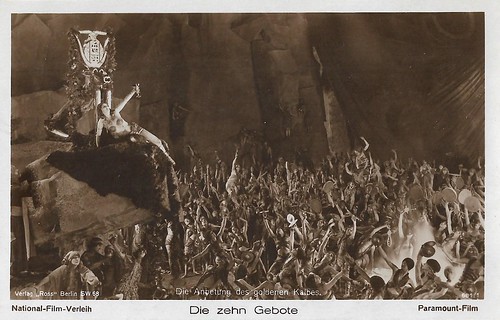
German postcard by Ross Verlag, no. 681/1. Photo: Paramount-Film / National-Verleih. Estelle Taylor is the woman who embraces the Golden Calf, in The Ten Commandments (Cecil B. DeMille, 1923). Caption: The Adoration of the Golden Calf.
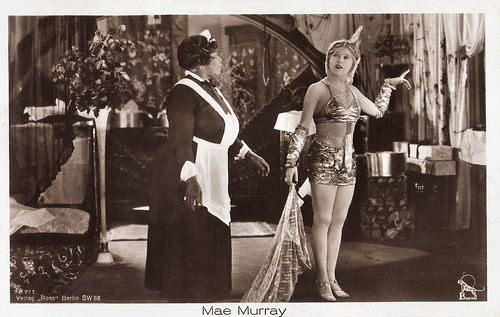
German postcard by Ross Verlag, no. 787/1. Photo: British-American-Films A.G. Balag. Photo: publicity still for Broadway Rose (Robert Z. Leonard, 1922) with Mae Murray and Pauline Dempsey.

German postcard by Ross Verlag, Berlin, no. 799/2, 1925-1926. Photo: Phoebus Film. Roscoe ‘Fatty’ Arbuckle.

German postcard by Ross Verlag, Berlin, no. 824/1, 1925-1926. Photo: British-American Films AG (BAFAG). Viola Dana.
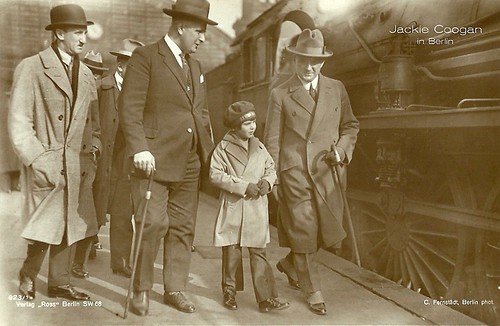
German postcard by Ross Verlag, Berlin, no. 923/1. Photo: C. Fernstädt, Berlin. Caption: Jackie Coogan in Berlin. The man at the far left is Coogan's father, John Henry 'Jack' Coogan Jr.
Hollywood comes to Berlin
The photo above was taken during Jackie Coogan European's tour in 1924. According to Wikipedia, Coogan, working with Near East Relief (NER), toured across the United States and Europe in 1924 on a "Children's Crusade" as part of his fundraising drive, which provided more than $1 million in clothing, food, and other contributions (worth more than $13 million in 2012 dollars), funds raised for Armenian genocide orphans. Coogan was honoured by officials in the United States, Greece, and Rome, where he had an audience with Pope Pius XI. Coogan may well have been the first star to use his status for a humanitarian cause. He for sure became known as the star with a conscience.
In addition, the tour promoted Coogan's film A Boy of Flanders, which, oddly enough, takes place in the Netherlands and not in Belgium (of which Flanders is a part). Coogan was also dressed up in a typical Volendammer (Dutch) folkloristic outfit. In The Netherlands, the film was therefore rebaptised 'Een Hollandsche jongen' (A Dutch Boy).
According to the newspapers, in September 1924, Jackie Coogan docked in Southampton with the SS Leviathan and then visited London, Paris, Rome, and Athens. Coogan was accompanied by his father Jack, his tutor Mrs. Kora Newell, and his manager and future stepfather, Arthur Bernstein. His mother stayed home, as she was expecting her second son. After ten days of holidays in early October in Semmering (Austria), the trip continued to Budapest, Vienna, and Berlin. Attempts to have him visit Amsterdam as well failed.
After a return to Paris, he took the ship back to the US on 4 November, as he had to work from 28 October on the film sets again. Huge crowds attended Coogan's visits, reaching its climax in October 1924 in Athens, according to his biographer Diana Serra Cary, when he handed over the bills of lading for the relief cargo in the presence of Greek and American dignitaries and some 7000 orphans in the care of Near East Relief.
Coogan was awarded with the Silver Cross of the Order of St. George. Way before TV or the internet, the media coverage of printed press, film magazines and newsreels on the tour was huge. The Ross Verlag postcards on Coogan's Berlin visit are part of this.

German postcard by Ross Verlag, no. 825/1, 1925-1926. Photo: British-American-Films A.G. (Bafag). Mae Murray in Peacock Alley (Robert Z. Leonard, 1922).
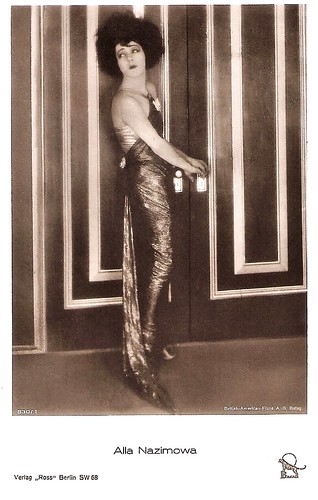
German postcard by Ross Verlag, no. 830/1, 1925-1926. Photo: British-American Films A.G. Balag. Publicity still for Camille (Ray C. Smallwood, 1921) featuring Alla Nazimova.
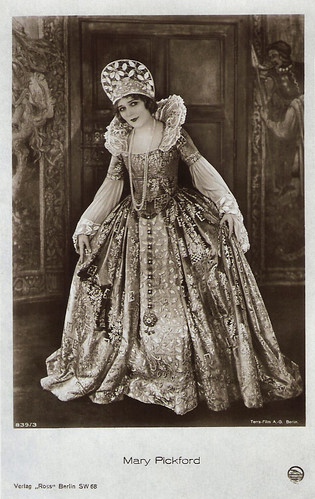
German postcard by Ross Verlag, no. 839/3. Photo: Terra Film A.G., Berlin. Publicity still for Dorothy Vernon of Haddon Hall (Marshall Neilan, 1924), featuring Mary Pickford.
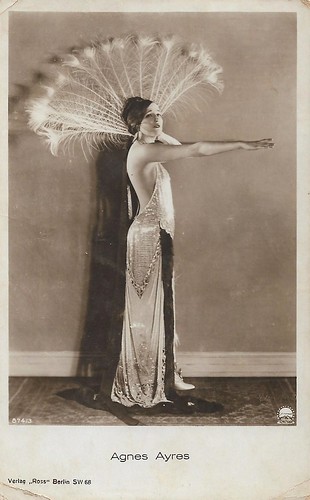
German postcard by Ross Verlag, no. 874/3, 1925-1926. Photo: Paramount. Agnes Ayres

German postcard by Ross Verlag, no. 1093/3. Photo: Paramount. Herbert Brenon directs Pola Negri, who plays a gipsy fortune teller in the American silent film The Spanish Dancer (1923).

German postcard by Ross Verlag, Berlin, no. 1166/1, 1927-1928. Photo: United Artists. Mary Pickford wears her dress from Little Annie Rooney (William Beaudine, 1925). This then seems to contradict the saying on the internet that this photo with Anna Pavlova was taken on the set of The Thief of Bagdad (Raoul Walsh, 1924). The German premiere of Little Annie Rooney, released in Germany as Die kleine Annemarie, took place in May 1926, with Mary Pickford and Douglas Fairbanks present.

German postcard by Ross Verlag, Berlin, no. 1242/1, 1927-1928. Photo: Paramount Film. Douglas Fairbanks Jr.
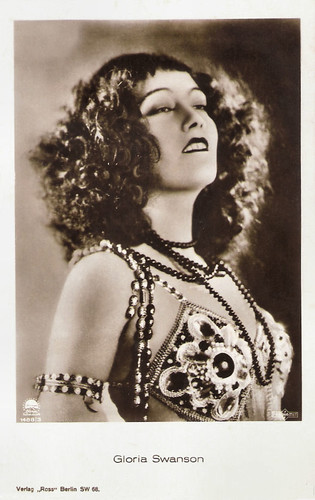
German postcard by Ross Verlag, no. 1488/3, 1927-1928. Photo: Paramount / Parafumet. Publicity still for Stage Struck (Allan Dwan, 1925), starring Gloria Swanson.

German postcard by Ross Verlag, no. 1852/1, 1927-1928. Photo: Max Munn Autrey / Fox. Janet Gaynor.
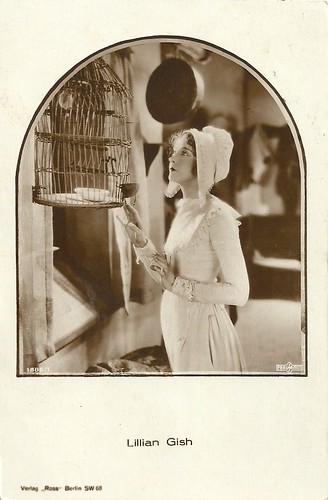
German postcard by Ross Verlag, no. 1885/1. Photo: Parufamet. Lillian Gish in The Scarlet Letter (Victor Sjöström, 1926).
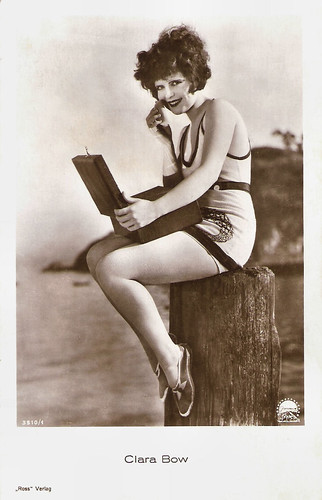
German postcard by Ross Verlag, no. 2510/1, 1928-1929. Photo: Paramount. Clara Bow.
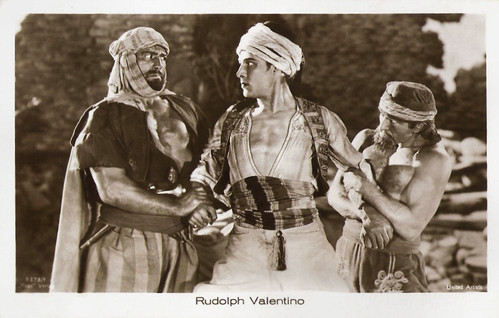
German postcard by Ross Verlag, no. 3373/1, 1928-1929. Photo: United Artists. Publicity still for The Son of the Sheik (George Fitzmaurice, 1926), starring Rudolph Valentino.
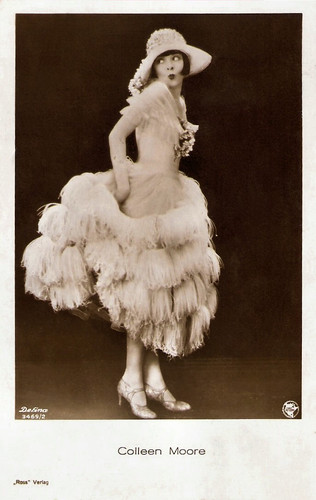
German postcard by Ross Verlag, no. 3469/2, 1928-1929. Photo: DeFina.Colleen Moore.
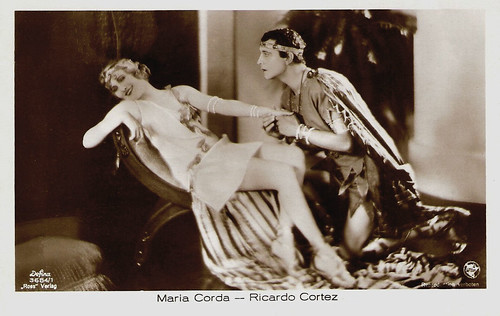
German postcard by Ross Verlag, no. 3684/1, 1928-1929. Photo: Defina. Publicity still for The Private Life of Helen of Troy (Alexander Korda, 1927) with Maria Corda and Ricardo Cortez.

German postcard by Ross Verlag, no. 3807/1, 1928-1929. Photo: Paramount. Louise Brooks holding two stuffed toys from the period – Dismal Desmond and Bonzo. Collection: Jean Ritsema / Ross Verlag Movie Star Postcards.
Sources: Thomas J. Saunders (Hollywood in Berlin: American cinema and Weimar Germany), Kristin Thompson (Exporting Entertainment: America in the World Film Market, 1907-1934), Wikipedia and IMDb.
Thanks, Jean! The Ross Verlag Tribute will be continued next week.
No comments:
Post a Comment